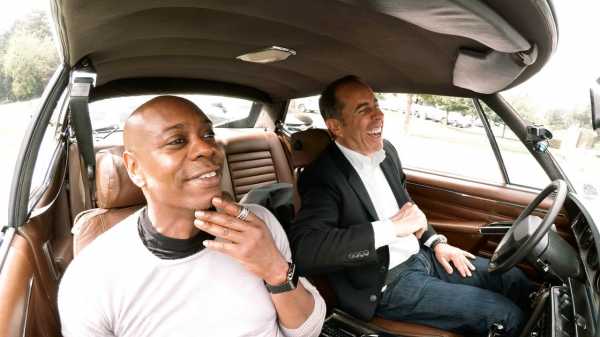
“Comedians in Cars Getting Coffee” began as a Web series on Crackle and now lives on Netflix, where its tenth season recently cruised into view. In each installment, Jerry Seinfeld pilots a photogenic car to the doorstep of a famous funny person. The twelve new episodes are slightly snappier than earlier ones, which sometimes allowed silences to speak of easy companionship or productive awkwardness. But the fundamental structure abides: Jerry and his passenger drive around, hang out, grab a bite to eat, and enact a chummy discourse on topics ranging from the philosophy of humor to theories of everyday life. It’s nonnutritive, but it has some pep.
Clearly the opportunity to borrow exotic vehicles was a prime motivation for Seinfeld, who is reported to own about four dozen Porsches, to create the show. The recent onscreen presence of the Lavazza logo, with its advertorial texture, suits the series’ vibe as a celebrity vanity project. The series itself plays like a benevolent promotional brochure, and gives the impression that the process was a passionate boondoggle. In one new episode, the topic of comedy-themed radio shows comes up, and Seinfeld asks, “How is it that we can’t get enough of any two idiots talking?” There is a note of grateful amazement in his self-indicting deprecation.
It requires only an iota of interest in automotive design to appreciate Seinfeld’s care in pairing guests with machines. The host matches John Mulaney with an Alfa Romeo that is, like Mulaney, forebodingly square at a casual glance but delightfully elegant in its particulars. Seinfeld chauffeurs Kate McKinnon in a cartoonish turquoise Fiat that looks, to him, “like a drip of gelato that fell off your spoon and just drove down the street.” Dave Chappelle warrants the sleek funk of a 1973 Citroën with a Maserati engine. The stage persona of Brian Regan nicely coördinates a violently blue Cadillac convertible coupé, built to suit midlife crises of the mid-two-thousands; Seinfeld lovingly disparages it as a car that tells its owner’s neighbors, “I’m doing better than you, but only with money. I’m an idiot in every other way.”
The guests tend to be more charming than funny, and it is possible to class the series as a laugh-a-minute event only because Seinfeld liberally peppers his repartee with encouraging chuckles. He draws out blips of insight, slips of memoir, footnotes on craft, old lines stored deep in the files, spontaneous riffs on banal business, and passing glimpses of private selves. Shortly upon taking her seat in a 1977 Toyota Land Cruiser, Ellen DeGeneres, liberated from the pressure to carry a bit or sell a clip, shares that her formative creative experience was a performance inspired by her grief at the accidental death of a girlfriend. (The act imagined an uncomprehending Ellen placing a phone call to a distant deity and enduring His celestial hold music.) Though this snippet of critical biography is not a revelation to DeGeneres’s fans, her way of discussing it had a glow of her open and offhand introspection. Bubbled behind the windshield with a legend, the guests seem unself-conscious, as if they were giving a candid performance to an audience of one.
Seinfeld, meanwhile, peels away a layer of his persona only to reveal another, identical layer. His deference and curiosity are sincere. His humility renders his smugness palatable, as when Mulaney asks him a big-picture question about his vision of the last chapter of his life: “How do you see your final ten years?” Jerry’s answer detours past the second noble truth of Buddhism: “There are things I want that I don’t have, but I don’t care that I don’t have them.”
Sourse: newyorker.com






